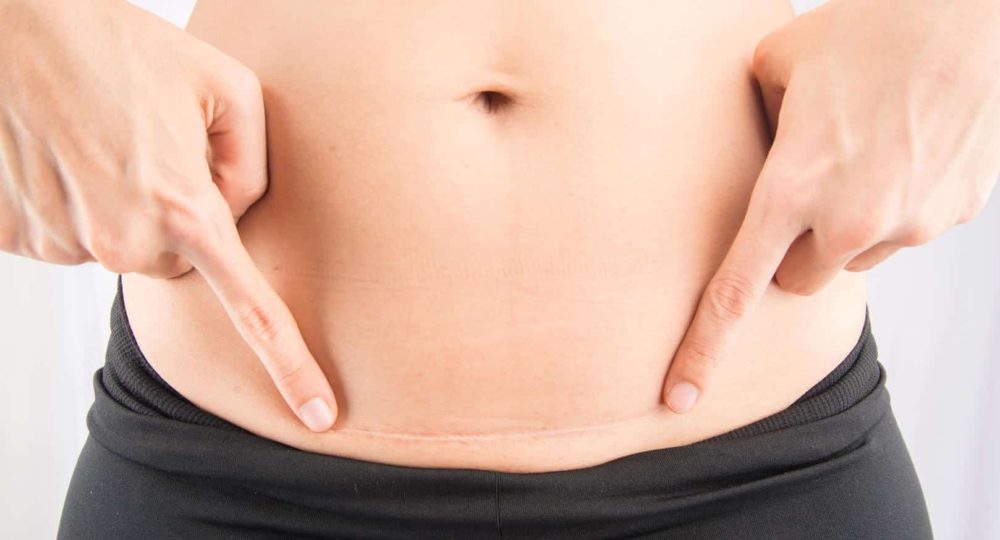Post C-Section Scar Healing & Treatment

There are a number of reasons why you may be a good candidate for a cesarean section, otherwise known as a C-section. Maybe your baby is positioned awkwardly in your uterus, your labour seems stuck in a certain phase and refuses to progress, or perhaps you simply have a health condition that makes vaginal delivery difficult.
Types of Incisions and Closures
Whatever the reason, the good news is that C-section scars are usually quite small. These scars are either vertical slightly below your navel or horizontal just below the bikini line, and the required location for your cesarean will depend on the circumstance or the person. In either circumstance, you may end up with an aggressive and stand-out scar, but it doesn’t have to be that way. You may only end up with a faded line that is barely noticeable if you treat your scar properly.
It should be noted that the vertical navel scar — also known as the classic cut — will often be much more pronounced or noticeable than the alternate horizontal bikini-cut scar. It’s not to say that a vertical classic scar couldn’t be faded out given the proper treatment, but it will generally produce a more pronounced scar than a bikini cut.
Given this consideration, have a talk with your doctor so that they understand what your goals are, and if when the time comes that they determine you need a C-section, they know what your preferences are. Your doctor may advise you that because of certain health or other types of considerations, you may only be eligible for one type of cesarean section. Although that does limit your options in terms of which type of incision you would like to have performed on your body, it at least takes the option off the table, and you know what you are getting into at the very beginning.
Additionally, how your C-section was closed could factor into how it heals. There are usually three different types of closures: surgical staples, surgical thread (stitches), or surgical glue. Surgical staples are a fast and simple method of closure, but may leave extra scarring. Stitches may produce the same results, but it is usually much less noticeable than with staples. Surgical glue gives the lowest potential for extra scarring, and while it is usually completely fine as a method for closing a wound, it does have the highest rate for complication of the three. If scarring is your main concern, glue is generally your best option, followed by stitches if you want extra certainty that your wound is especially securely closed after surgery. Again, talk to your doctor to find the solution that is right for you and get their opinion on how they think you should proceed.
General Incision Care
Now that you have a good idea of how the different types of incisions could affect your healing process, it’s a good idea to look at how to properly care for your incisions. Reinjury and infection is not uncommon when people mistreat their wounds, and it really comes down to small things that you can do to ensure your wound is taken care of properly.
First, it is especially important to ensure you are cleaning your wound daily, and properly. A fresh wound like this is a fairly large entry point for germs and other pathogens of concern to enter the body, so it is important for those to be washed away regularly. The heat from the shower would likely do you additional good. Since this is also a fairly tender and fragile area for the first little while, you should let soap and water run over your incision without scrubbing at it. Your incision should also be pat-dried carefully, as even a simple wiping motion can cause damage to your closure.
Tight clothes are a big problem when you have sensitive skin or wounds in the early stages of healing. With enough movement, it can irritate your incision and cause it to become inflamed and increase your chances of scarring. Loose pajamas, baggy shirts, jogging pants, and other types of loose-fitting clothing will go a long way to ensuring that your incision gets the breathing room it needs.
Follow your doctor’s directions closely. They will give you instructions on how long you shouldn’t be exercising, including bending over and lifting heavy objects, as well as the type of pain relievers you may consider. Each and every doctor’s appointment is additionally important because they can monitor your healing process closely and identify any complications that may occur early on.
Minimize Scarring
Naturally, there is no way of knowing how a scar will heal, as everyone is different. However, there are a few practices that have been known to help in some scenarios to produce a smaller scar.
Scar revision is the process of opening and reclosing the scar through an additional minor surgery, removing damaged skin in an attempt to blend it with the surrounding skin. It has some degree of success, but it is usually only considered after your scar has healed and it hasn’t healed in the way you would have liked it to.
Steroid injections, laser therapy, and new developments in kinesiology tape have been shown to be effective in reducing inflammation of scar tissue. Steroids are usually administered in monthly injections until the desired results are achieved, lasers involve using beams of light to soften scars and remove raised tissue, and special scar tape uses a gentle lifting action to allow more space for inflammation to subside.
Finally, once your scar has healed, give scar massaging a try. Gently massaging in a circular motion with one finger for about five to ten minutes a day promotes blood flow, encouraging cell growth and helping to fade the scar over time. Consider using a natural vitamin E cream to make it easier to massage and moisturize the skin.
These are just a few of the ways that you can help heal your scar. Applying a care method that is careful and considerate of your scar can help you to have more natural and beautiful skin. Find the methods that work best for you and feel good in your skin!
Author’s Bio
Daniel Johnston is a content writer currently working for BreezeMaxWeb. He is a dedicated
writer and loves everything about geology, having previously studied with the Gemological
Institute of America in New York.
Leave a reply
You must be logged in to post a comment.







